
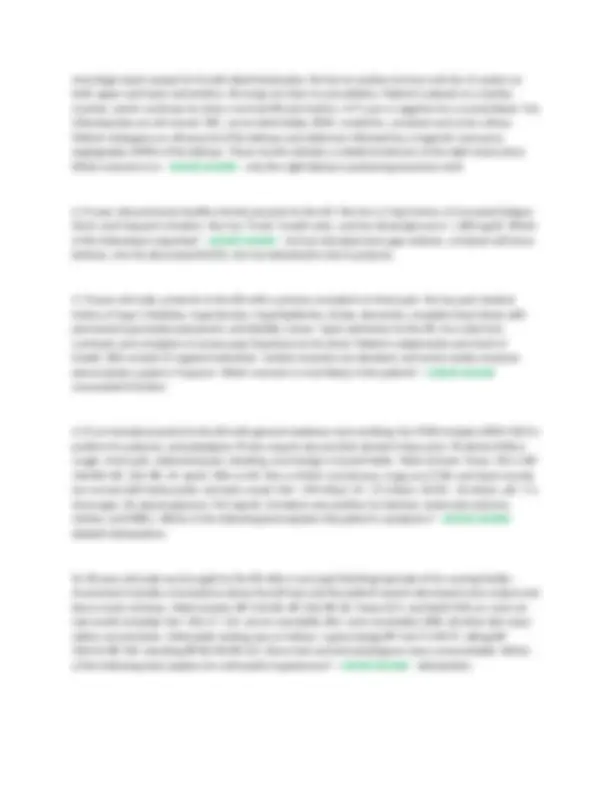
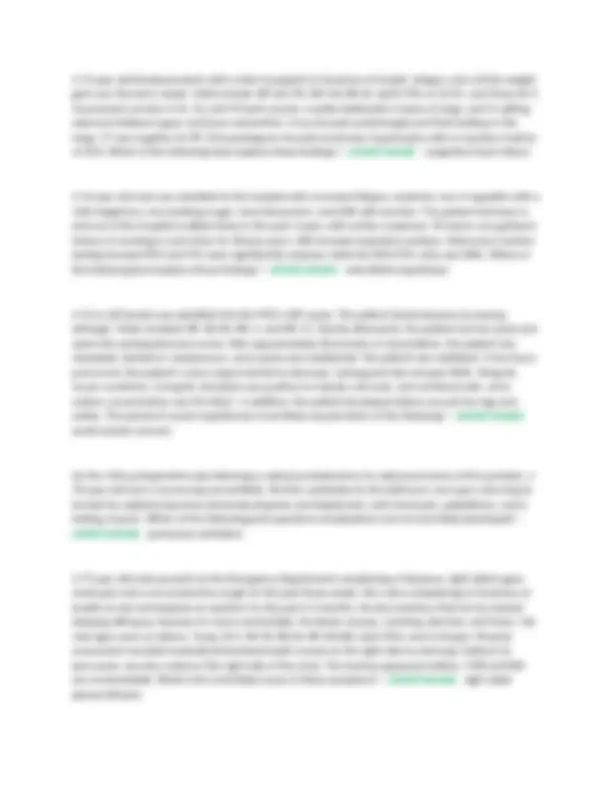
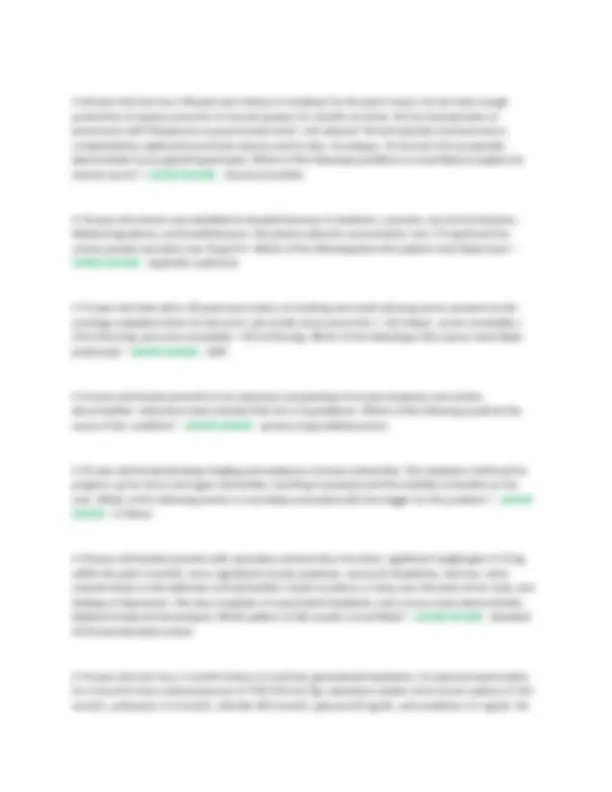
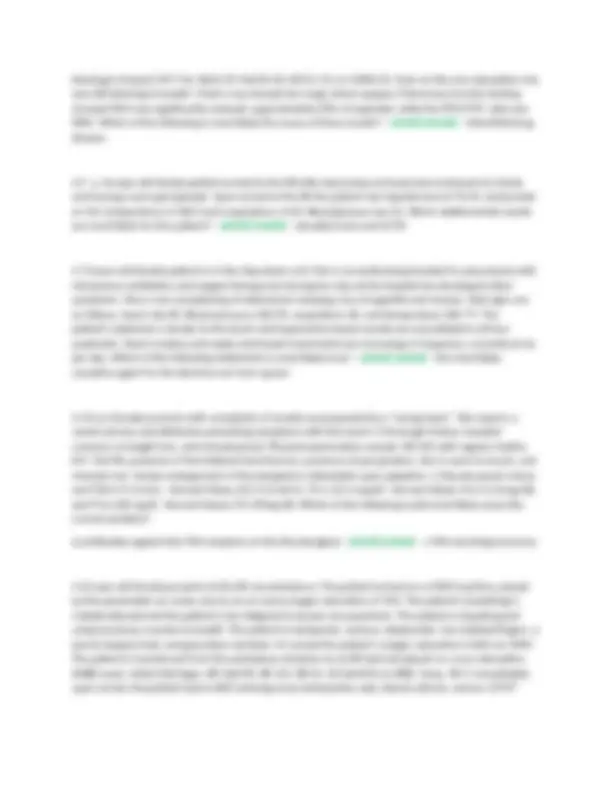
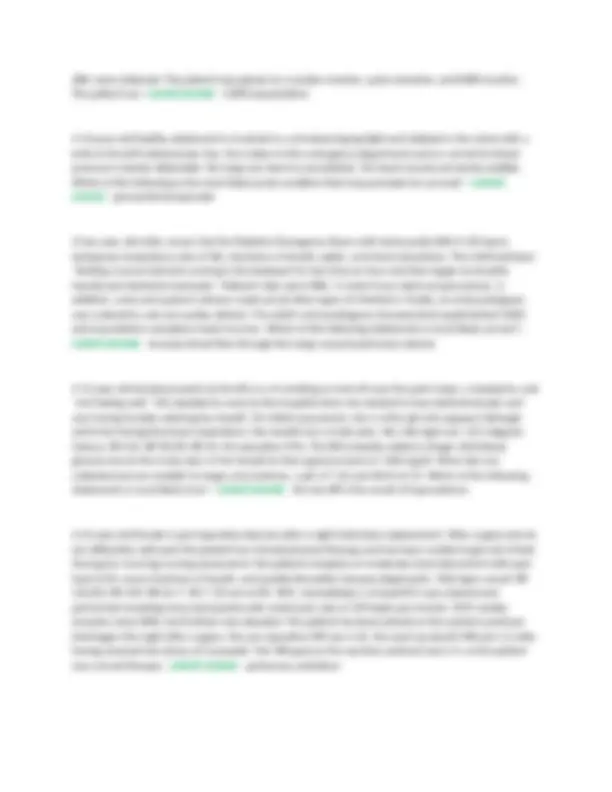
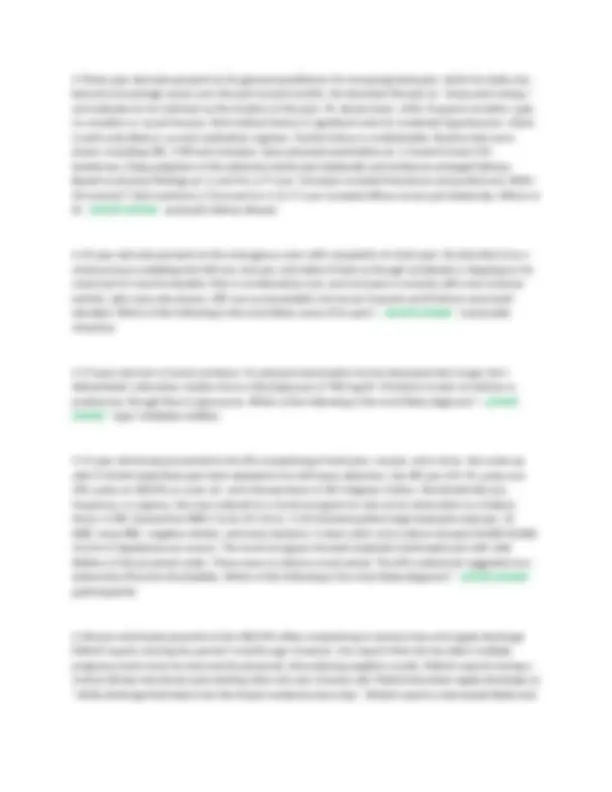
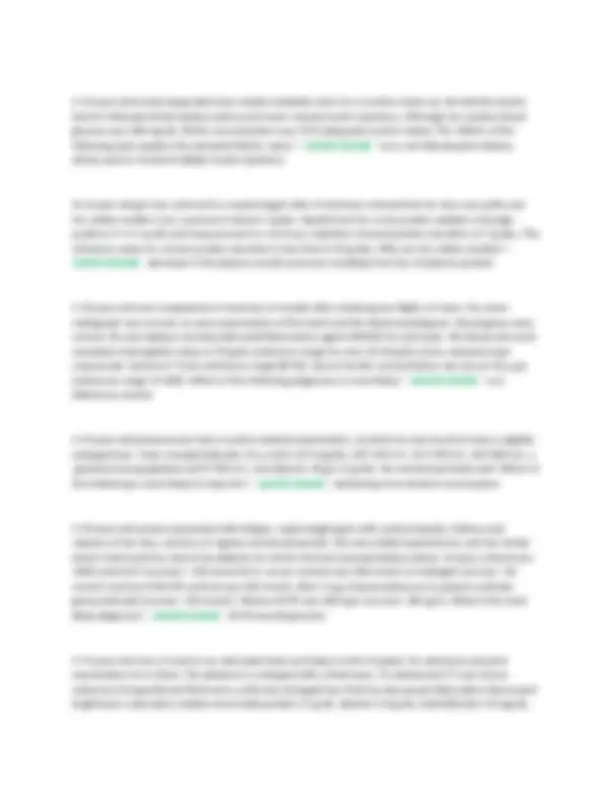
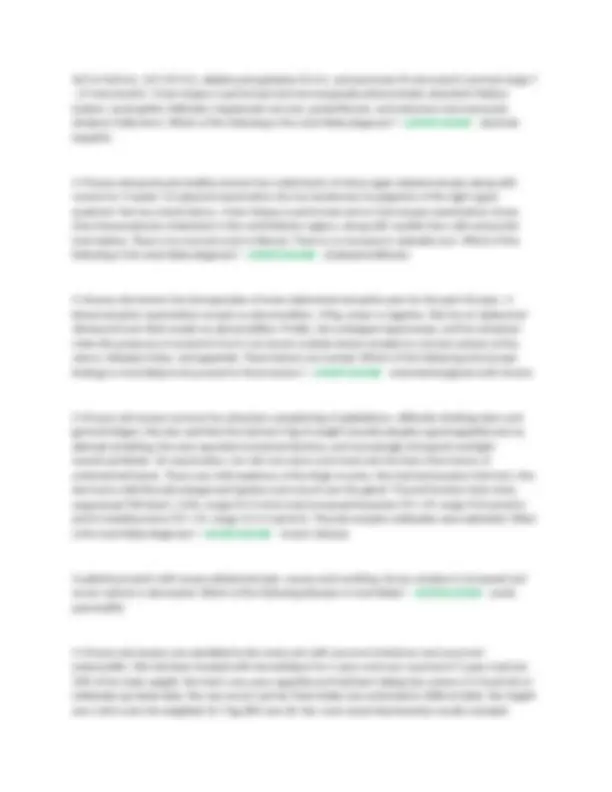
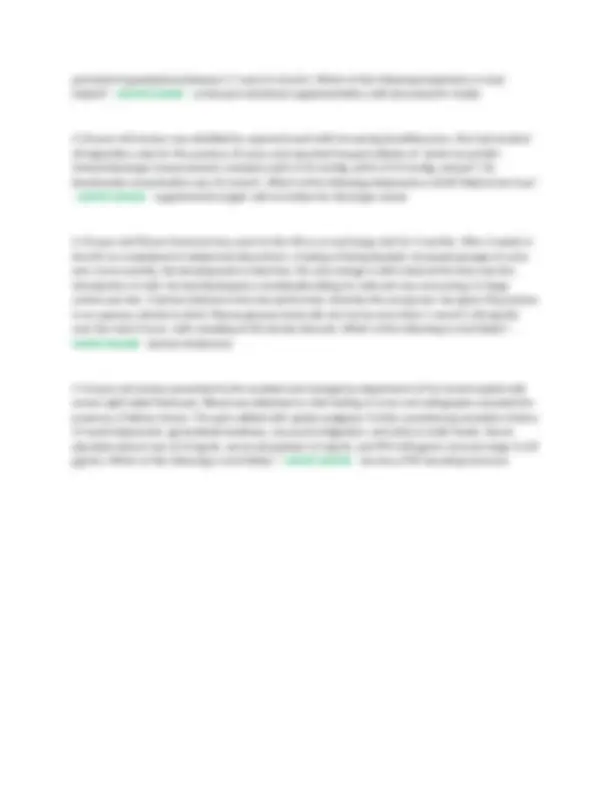


Study with the several resources on Docsity

Earn points by helping other students or get them with a premium plan


Prepare for your exams
Study with the several resources on Docsity

Earn points to download
Earn points by helping other students or get them with a premium plan
Community
Ask the community for help and clear up your study doubts
Discover the best universities in your country according to Docsity users
Free resources
Download our free guides on studying techniques, anxiety management strategies, and thesis advice from Docsity tutors
Pathophysiology Case Studies Exam Already Graded A+
Typology: Exams
1 / 15

This page cannot be seen from the preview
Don't miss anything!










A 54 year old female patient arrived to the ER after becoming confused and incoherent to family and having a syncopal episode. Upon arrival to the ER the patient was hypotensive at 75/45, tachycardic at 123, temperature of 100.3 and RR of 20. Blood glucose was 56. CBC was within normal limits. BMP results showed K+ 6.0 mM and Na+ 127 mM. Further lab tests showed cortisol was decreased and ACTH was increased, compared with normal. Which of the following is most likely? - correct answer Addison's disease Two weeks after orthopedic surgery, a 62 year-old female presented with uncontrolled pain and purulent drainage from the surgical incision. She was admitted and taken to the OR for irrigation and debridement of the infection site. Additionally, she was started on antibiotics to control the infection. Later that week she started having 3-4 foul smelling watery stools a day, became febrile, and complained of N/V. Which of the following pathogens is most likely causing her abdominal problems? - correct answer C. diff A 56 year-old male presents with no specific complaint. He works as a truck driver and has been in 2 accidents recently and his boss insists that he gets "checked out" by a medical professional before he can drive again. He claims that objects suddenly appear from out of nowhere. He admits to recent loss of libido and erectile dysfunction. Which of the following is most likely? - correct answer prolactinoma A 63 year-old male presents with depression, confusion, vague pains in his bones, and ulcers. He was recently diagnosed with kidney stones. Blood tests reveal that PTH is decreased, while both serum Ca++ and phosphate are increased. Which of the following is most likely? - correct answer metastatic bone cancer The mother of a 2-year old girl brings her daughter to the pediatrician's office. The mother states that the patient has had frequent watery, foul smelling and sometimes greasy stools on and off for the past 3 months. At other times she seems to be constipated. She is noticeably small for her age - in the 50th percentile for height and 25th percentile for weight. The mother also reports that after the patient's last cold, the cough did not subside for several weeks and each cough was producing thick, grayish mucus. Her medical record shows 3 hospitalizations in the past 2 years from respiratory tract infections, all of which were treated with antibiotics. Today, she appears to be in good health with no apparent cough, but she looks malnourished and pale. Abdominal ultrasound showed no obstructions or mechanical blockages, and stool culture revealed normal bacterial growth, without viral infection. Stool sample was po - correct answer cystic fibrosis
A 2 month-old female presents for evaluation of poor feeding. She is in no apparent acute distress, but mom reports that she has difficulty with feeding and get short of breath at times. Mom is concerned that the baby seems to be losing weight and is excessively tired. The baby's weight is below average for age and length. She is alert at this time and does not appear to be in any acute distress. Respiratory rate is 41, and auscultation reveals crackles in bilateral bases. Patient is afebrile and has strong peripheral pulses in upper and lower extremities. Auscultation reveals a HR of 140 with a continuous murmur. Which scenario is most likely in this patient? - correct answer patent ductus ateriosus A 72 year old male presents to the ED comatose. Vitals are HR 132 (Sinus Tachycardia), BP 87/45. CMP shows blood glucose 2250 (mg/dl), pH 7.41, Na+ 133, K+ 4.6, Cl- 97, HCO3- 23, and serum osmolarity 356 mOsm. Which scenario is most likely in this patient? - correct answer hyperosmolar hyperglycemic non-ketotic syndrome One week after a severe strep throat, a 6 year old female patient presents with oliguria. Which type of glomerular nephritis is most likely in this patient? - correct answer acute proliferative (postinfectious) glomerulonephritis A 34 y/o female presents to the ED with anxiety, palpitations, and chest pain. She is currently receiving radiation to the chest as a result of breast cancer. She denies fever, chills, SOB, cough, abdominal pain, or N/V/D. Vital signs are: T 98.9, BP 90/60, HR 100, RR 26, SpO2 98% RA. Lungs are clear to auscultation bilaterally. Heart shows regular rhythm with weak S1, S2, and faint rub. Jugular venous distension is present. Peripheral pulses are weak bilaterally. EKG shows normal sinus rhythm with decreased voltage. Chest x-ray shows increased cardiac silhouette. Echocardiogram is positive for effusion. Which scenario is most likely in this patient? - correct answer cardiac tamponade A 23 year-old male presented to the ED with complaints of chest pain of 19 months duration. Chest pain was aggravated by strenuous activities and moderately relieved with rest. Patient stated a history of dyspnea on exertion and effort intolerance since childhood. Patient remembered frequent squatting to relieve episodes of breathlessness following exertion. Patient denies history of cough, change in urine or bowels, leg swelling, nocturia or oliguria. General examination showed central cyanosis with digital clubbing. Pulse was regular with a rate of 80 BPM, and BP was 120/70 mmHg. Cardiac examination found a systolic murmur. The lungs were clear and abdomen was non-tender. Chest radiograph showed enlarged heart with pulmonary oligemia with right ventricular hypertrophy. There was no aortic or mitral regurgitation. Patient Hct was 72%. Which scenario is most likely in this patient? - correct answer Tetralogy of Fallot A 3 year old presents to the ER with acute left sided facial palsy. Patient's mother states her son has been irritable over the last few weeks. His current VS include: 36.6 degrees C, HR 80 bpm in sinus rhythm, BP 180/110, RR 22, and oxygen saturation of 99% on RA. On assessment, patient has a normal
A 76 year old female presents with a chief complaint of shortness of breath, fatigue, and a 20 lbs weight gain over the last 6 weeks. Vitals include: BP 165/78, HR 118, RR 26, SpO2 94% on 3L NC, and Temp 36.9. Assessment consists of S1, S2, and S3 heart sounds, crackles bilaterally in bases of lungs, and 3+ pitting edema to bilateral upper and lower extremities. X-ray showed cardiomegaly and fluid buildup in the lungs. CT was negative for PE. Echocardiogram showed ventricular hypertrophy with an ejection fraction of 35%. Which of the following best explains these findings? - correct answer congestive heart failure A 56 year old male was admitted to the hospital with increased fatigue, weakness, loss of appetite with a 12lb weight loss, dry hackling cough, chest discomfort, and SOB with exertion. The patient had been in and out of the hospital multiple times in the past 3 years with similar symptoms. Pt had an occupational history of working in coal mines for 30 plus years. ABG showed respiratory acidosis. Pulmonary function testing showed FEV1 and FVC were significantly reduced, while the FEV1/FVC ratio was WNL. Which of the following best explains these findings? - correct answer interstitial lung disease A 52 yr old female was admitted into the MICU with sepsis. The patient slowly became increasing lethargic. Vitals included: BP: 60/30, RR: 6, and HR: 55. Shortly afterwards, the patient lost her pulse and went into cardiopulmonary arrest. After approximately 30 minutes of resuscitation, the patient was intubated, started on vasopressors, and a pulse was established. The patient was stabilized. A few hours post arrest, the patient's urine output started to decrease. Subsequent labs showed: BUN: 34mg/dl, serum creatinine: 2.6mg/dl. Urinalysis was positive for tubular cell casts, and red blood cells, urine sodium concentration was 50 mEq/L. In addition, the patient developed edema around her legs and ankles. The period of severe hypotension most likely caused which of the following? - correct answer acute tubular necrosis On the 11th postoperative day following a radical prostatectomy for adenocarcinoma of the prostate, a 70-year-old man is recovering uneventfully. He then ambulates to the bathroom, but upon returning to his bed he suddenly becomes extremely dyspneic and diaphoretic, with chest pain, palpitations, and a feeling of panic. Which of the following post-operative complications has he most likely developed? - correct answer pulmonary embolism A 72 year old male presents to the Emergency Department complaining of dyspnea, right sided upper chest pain and a non-productive cough for the past three weeks. He is also complaining of shortness of breath at rest and dyspnea on exertion for the past 2-3 months. He also mentions that he has started sleeping sitting up, because it's more comfortable. He denies nausea, vomiting, diarrhea, and fevers. His vital signs were as follows: Temp 35.9, HR 78, RR 28, BP 130/80, SaO2 95%, and 4/10 pain. Physical assessment revealed markedly diminished breath sounds on the right side to mid-lung. Dullness to percussion was also noted on the right side of the chest. The trachea appeared midline. CMP and EKG are unremarkable. What is the most likely cause of these symptoms? - correct answer right sided pleural effusion
A 60-year-old man has a 90 pack year history of smoking. For the past 5 years, he has had a cough productive of copious amounts of mucoid sputum for months at a time. He has had episodes of pneumonia with Streptococcus pneumoniae and E. coli cultured. His last episode of pneumonia is complicated by septicemia and brain abscess and he dies. At autopsy, his bronchi microscopically demonstrate mucus gland hypertrophy. Which of the following conditions is most likely to explain his clinical course? - correct answer chronic bronchitis A 44-year-old woman was admitted to hospital because of weakness, anorexia, recurrent infections, bilateral leg edema, and breathlessness. Her plasma albumin concentration was 1.9 mg/dl and her urinary protein excretion was 10 g/24 h. Which of the following does this patient most likely have? - correct answer nephrotic syndrome A 54 year-old male with a 30 pack-year history of smoking and small cell lung cancer presents to the oncology outpatient clinic for lab work. Lab results show serum Na+ = 123 mEq/L, serum osmolality = 276 mOsm/kg, and urine osmolality = 559 mOsm/kg. Which of the following is this cancer most likely producing? - correct answer ADH A 42-year-old female presents to her physician complaining of muscle weakness and cardiac abnormalities. Laboratory tests indicate that she is hypokalemic. Which of the following could be the cause of her condition? - correct answer primary hyperaldosteronism A 35 year old female develops tingling and weakness of lower extremities. The weakness continued to progress up her torso and upper extremities resulting in paralysis and the inability to breathe on her own. Which of the following events is most likely associated with the trigger for this problem? - correct answer GI illness A 33-year-old female presents with secondary amenorrhea, hirsutism, significant weight gain of 15 kg within the past 2 months, acne, significant muscle weakness, recurrent headaches, hair loss, wine- colored striae on the abdomen and extremities, facial roundness, a lump over the back of her neck, and feelings of depression. She also complains of a persistent headache, and a neuro exam demonstrates bilateral temporal hemianopsia. Which pattern of lab results is most likely? - correct answer elevated ACTH and elevated cortisol A 45-year-old man has a 4 month history of nonfocal, generalized headaches. On physical examination he is found to have a blood pressure of 170/110 mm Hg. Laboratory studies show serum sodium of 146 mmol/L, potassium 2.3 mmol/L, chloride 103 mmol/L, glucose 82 mg/dL, and creatinine 1.2 mg/dL. His
A 76 year old female presented to the emergency department with a complaint of shortness of breath that had become progressively worse over the past two days. The patient had palpitations; labored, shallow and increased rate of breathing with use of accessory muscles; crackles heard over bilateral lung bases; a non-productive cough; ankle edema and anxiety. She confirmed having a past medical history of diabetes, obesity, hypertension, and heart attack one year ago. Initial vital signs were: temp 98.7, HR 111, BP 140/80, RR 30, O2-Sat: 88 on room air. A stat EKG was done, which showed sinus tachycardia. CBC, BMP, and cardiac enzymes were wnl, but BNP was elevated. A stat chest x-ray was also done, which portrayed an enlarged cardiac silhouette and bilateral pleural congestion. Which of the following is most likely the cause of these results? - correct answer CHF A 26 year old woman presented to her OBGYN's office complaining of fever, bilateral flank pain, nausea, aches, chills, dysuria, hematuria, and urinary frequency. Her BP was 128/82, pulse was 100, O2-sat was 99% on room air, and temperature was 38.7 degrees Celsius. She rated her bilateral flank pain as 8/10. She reported experiencing urinary frequency with dysuria and hematuria for the past 24 hours and reported nausea, but denied vomiting. A CT scan of her abdomen and pelvis ruled out kidney stones or an obstruction. Urinalysis was positive for leukocyte esterase. CBC showed that both white blood cell count and neutrophil count were elevated. Which of the following renal problems is most likely to be present in this situation? - correct answer pyelonephritis A 16 year-old female presents to the ED with a 2 day history of polyuria, polydipsia, fatigue, nausea, and disorientation. Blood tests show: Na+ 137 mM, Cl- 96 mM, HCO3- 14 mM, blood glucose 567 mg/dl, serum osmolarity 294 mOsm/L, PaCO2 32 mmHg, pH 7.26. Which of the following statements is LEAST likely to be true? - correct answer she has hyperosmolar hyperglycemic nonketotic syndrome A 53 year-old male was in the ICU with viral pneumonia; throughout his ICU stay he steadily declined. He went into respiratory distress two days after admission and was intubated and a central line was placed. Subcutaneous heparin was given prophylactically to prevent thrombus formation. His BP dropped and he was started on a vasopressor medication. His ventilator settings were increased. An arterial line was placed for blood draws. The bedside nurse noticed the patient coughing up large amounts of think frothy bright blood in his endotracheal tube on day six of admission. The patient was also oozing blood from his central line and arterial line puncture sites. Increased ecchymosis (bruising) was noted on extremities. Urine output was 10-20 ml an hour (low). Labs were sent to look for bleeding cause. Significant lab results were: Hbg 6.8 HCT 22.0, WBC count 24,000, ABG: pH 7.1, PaCO2 36, Bicarb 15, platelet count 12, - correct answer DIC A 56 year old female presented to the ER with dry cough for the last month and shortness of breath. Patient has a history of HTN, DM, and breast cancer. EMT found her tachypneic with labored breathing. They immediately placed a non-rebreather on her. When she arrived to the ER she was lethargic. The
blood gas showed: PH 7.46, PaO2 59, PaCO2 30, HCO3- 23, on 100% O2. Even on the non-rebreather she was still laboring to breath. Chest x-ray showed her lungs where opaque. Pulmonary function testing showed FEV1 was significantly reduced, approximately 50% of expected, while the FEV1/FVC ratio was WNL. Which of the following is most likely the cause of these results? - correct answer interstitial lung disease A.F. a, 46 year old female patient arrived to the ER after becoming confused and incoherent to family and having a syncopal episode. Upon arrival to the ER the patient was hypotensive at 75/45, tachycardic at 123, temperature of 100.3 and respirations of 20. Blood glucose was 56. Which additional lab results are most likely for this patient? - correct answer elevated renin and ACTH A 72-year-old female patient is in the step-down unit. She is currently being treated for pneumonia with intravenous antibiotics and oxygen therapy but during her stay at the hospital has developed other symptoms. She is now complaining of abdominal cramping, loss of appetite and nausea. Vital signs are as follows: heart rate 85, Blood pressure 130/70, respirations 20, oral temperature 100.7˚F. The patient's abdomen is tender to the touch and hyperactive bowel sounds are auscultated in all four quadrants. Stool is watery and seedy and bowel movements are increasing in frequency, currently at six per day. Which of the following statements is most likely true? - correct answer the most likely causative agent for the diarrhea can form spores A 32 y/o female presents with complaints of anxiety accompanied by a "racing heart." She reports a recent job loss and attributes presenting symptoms with this event. A thorough history revealed concerns of weight loss, and missed period. Physical examination reveals: HR 105 with regular rhythm, B.P. 132/90, presence of fine bilateral hand tremor, presence of perspiration, skin is warm to touch, and minimal non- tender enlargement of thyroid gland is detectable upon palpation. A thyroid panel is done and TSH is 9.3 mU/L - Normal Values (0.5-5.0 mU/L), T4 is 12.5 mcg/dl - Normal Values (4.6-11.2mcg/dl), and T3 is 205 ng/dl - Normal Values (75-195ng/dl). Which of the following could most likely cause the current problem? a) antibodies against the TSH receptors on the thyroid gland - correct answer a TSH secreting hormone A 62 year old female presents to the ER via ambulance. The patient arrived on a CPAP machine, placed by the paramedics en route, due to an on scene oxygen saturation of 76%. The patient's breathing is notably labored and the patient is too fatigued to answer any questions. The patient is tripoding and using accessory muscles to breath. The patient is tachypneic, anxious, diaphoretic, has clubbed fingers, a barrel shaped chest, and grey/blue nail beds. On arrival the patient's oxygen saturation is 86% on CPAP. The patient is transferred from the ambulance stretcher to an ER bed and placed on a non-rebreather (NRB) mask. Initial Vital Signs: BP 160/90, HR 112, RR 32, O2 Sat 84% on NRB, Temp. 98.4. Immediately upon arrival, the patient had an EKG showing sinus tachycardia. Labs, blood cultures, and an i-STAT®
A Thirty year old male presents to his general practitioner for increasing back pain, which he states has become increasingly worse over the past several months. He describes the pain as "sharp and crampy," and indicates to his mid back as the location of the pain. Pt. denies fever, chills, frequent urination, pain on urination or recent trauma. Past medical history is significant only for moderate hypertension, which is well controlled on current medication regimen. Family history is unobtainable. Routine labs were drawn, including CBC, CMP and urinalysis. Upon physical examination pt. is found to have CVA tenderness. Deep palpation of the abdomen elicits pain bilaterally and evidences enlarged kidneys. Based on physical findings pt. is sent for a CT scan. Urinalysis revealed hematuria and proteinuria; BUN= 40 (normal 7-18) Creatinine 2.7(normal 0.6-1.2); CT scan revealed diffuse renal cysts bilaterally. Which of th - correct answer polycystic kidney disease A 65 year old male presents to the emergency room with complaints of chest pain. He describes it as a chest pressure radiating into left arm and jaw, and states it feels as though somebody is stepping on his chest and it is hard to breathe. Pain is unrelieved by rest, and increases in severity with even minimal activity. Labs were also drawn; CBC was unremarkable, but serum troponin and D-dimer were both elevated. Which of the following is the most likely cause of his pain? - correct answer myocardial infarction A 57-year-old man is found comatose. On physical examination he has decreased skin turgor (he's dehydrated). Laboratory studies show a blood glucose of 780 mg/dl. Urinalysis reveals no ketosis or proteinuria, though there is glucosuria. Which of the following is the most likely diagnosis? - correct answer type II diabetes mellitus A 31 year old female presented to the ED complaining of back pain, nausea, and a fever. She woke up with 9/10 left sided flank pain that radiated to her left lower abdomen. Her BP was 137/76; pulse was 104; pulse ox 100.0% on room air; and a temperature of 38.4 degrees Celsius. She denied dysuria, frequency, or urgency. She was ordered for a renal sonogram to rule out an obstruction or a kidney stone. A CBC showed her WBC's to be 19.3 k/uL. A UA showed positive large leukocyte esterase, 12 WBC, trace RBC, negative nitrites, and many bacteria. A clean catch urine culture showed 10,000-50, cfu/ml of staphylococcus aureus. The renal sonogram showed moderate hydronephrosis with mild dilation of the proximal ureter. There were no obvious renal calculi. The left ureteral jet suggested non- obstructive flow into the bladder. Which of the following is the most likely diagnosis? - correct answer pyelonephritis A 28-year-old female presents to the OB/GYN office complaining of amenorrhea and nipple discharge. Patient reports missing her period 5 months ago; however, she reports that she has taken multiple pregnancy tests since her last menstrual period, all producing negative results. Patient reports having a normal 28-day menstrual cycle starting when she was 13-years-old. Patient describes nipple discharge as "white discharge that leaks from the breast randomly every day". Patient reports a decreased libido and
vaginal dryness with intercourse and denies any other sexual dysfunction. Remainder of physical exam is unremarkable. Which of the following disorders is most likely? - correct answer prolactinoma A 35-year-old woman has had insomnia for the past 4 months. On physical examination, she exhibits bilateral proptosis (mild exophthalmia). Her outstretched hands have a fine tremor. On palpation of her neck, the thyroid gland appears to be enlarged, but no masses are palpable. Laboratory studies show a serum TSH of 0.2 microU/mL (normal 0.4 - 5.0 microU/mL) in association with a serum free thyroxine of 5.1 ng/dL (normal 0.8 - 1.8 ng/dL). Which of the following is the most likely diagnosis? - correct answer Grave's disease A 19-year-old female presents to the OB/GYN office complaining of amenorrhea. She reports that she has never experienced menstruation or vaginal spotting. Past medical history is significant for a heart murmur discovered in early childhood, delayed growth in development beginning at the age of four and chronic middle ear infections. Physical exam is significant for delayed development of secondary sexual characteristics. Patient's chest is broad; nipples are widely spaced with minimal breast bud elevation. Subtle webbing of the neck with low posterior neckline is noted. Which of the following disorders is most likely? - correct answer Turner's syndrome A 42-year-old female presents to her physician complaining of muscle weakness, depression, and cardiac abnormalities. Laboratory tests indicate that she is hypercalcemic, with normal serum sodium and potassium. Which of the following could best explain her symptoms? - correct answer primary hyperparathyroidism A 46 year-old female arrived to the ER after becoming confused and incoherent and having a syncopal (fainting) episode. Upon arrival to the ER the patient was hypotensive at 75/45, tachycardic at 123, temperature of 100.3 and respirations of 20. Blood glucose was 56. Which of the following disorders could explain both the hypotension and hypoglycemia? - correct answer Addison's disease A 31-year-old woman who has two healthy children, notes that she has had no menstrual periods for the past 6 months, but she is not pregnant and takes no medications. Within the past week, she has noted some milk production from her breasts. She has been bothered by headaches for the past 3 months. After nearly hitting a bus while changing lanes driving her vehicle, she is concerned with her vision. An optometrist finds her lateral vision to be reduced. On physical examination she is afebrile and normotensive. Which of the following laboratory test findings is most likely to be present in this woman? - correct answer pituitary necrosis A 29-year-old primigravida who received no prenatal care has marked vaginal bleeding after the onset of labor at 38 weeks gestation. Cesarean section is performed and a lacerated low-lying placenta is
A 15-year-old insulin-dependent boy visited a diabetic clinic for a routine check-up. He told the doctor that he followed all the dietary advice and never missed insulin injections. Although his random blood glucose was 108 mg/dL, HbA1c concentration was 11% (adequate control: below 7%). Which of the following best explains the elevated HbA1c value? - correct answer he is not following the dietary advice and/or missed multiple insulin injections An 8-year-old girl was referred to a nephrologist after it had been noticed that her face was puffy and her ankles swollen over a period of about 2 weeks. Dipstick test for urine protein yielded a strongly positive (++++) result and measurement in a 24-hour collection showed protein excretion of 7 g/day. The reference value for urinary protein excretion is less than 0.15 g/day. Why are her ankles swollen? - correct answer decrease in the plasma oncotic pressure resutling from loss of plasma protein A 35-year-old man complained of shortness of breath after climbing two flights of stairs. His chest radiograph was normal, as were examination of the heart and the electrocardiogram; blood gases were normal. He was taking a nonsteroidal antiinflammatory agent (NSAID) for joint pain. His blood cell count revealed a hemoglobin value of 10 g/dL (reference range for men 13-18 g/dL) and a reduced mean corpuscular volume of 72 dL (reference range 80-96). Serum ferritin concentration was low at 10 μ g/L (reference range 14-200). Which of the following diagnoses is most likely? - correct answer iron deficiency anemia A 45-year-old businessman had a routine medical examination, at which he was found to have a slightly enlarged liver. Tests revealed bilirubin 15 μ mol/L (0.9 mg/dL), AST 434 U/L, ALT 198 U/L, ALP 300 U/L, γ -glutamyl transpeptidase (γGT) 950 U/L, and albumin 40 g/L (4 g/dL). He seemed perfectly well. Which of the following is most likely to help him? - correct answer abstaining from alcohol consumption A 45-year-old woman presented with fatigue, rapid weight gain with central obesity, fullness and redness of her face, and loss of regular menstrual periods. She was mildly hypertensive, and her family doctor had found her also to be diabetic for which she had received dietary advice. Urinary cortisol was 1000 nmol/24 h (normal < 250 nmol/24 h); serum cortisol was 500 nmol/L at midnight (normal < 50 nmol/L) and her 8:00 AM cortisol was 550 nmol/L after 1 mg of dexamethasone (a potent synthetic glucocorticoid) (normal < 50 nmol/L). Plasma ACTH was 100 ng/L (normal < 80 ng/L). What is the most likely diagnosis? - correct answer ACTH secreting tumor A 41-year-old man is found in an obtunded state and taken to the hospital. On admission physical examination he is icteric. His abdomen is enlarged with a fluid wave. An abdominal CT scan shows extensive intraperitoneal fluid and a uniformly enlarged liver that has decreased attenuation (decreased brightness). Laboratory studies show total protein 6.5 g/dL, albumin 2.8 g/dL, total bilirubin 4.8 mg/dL,
AST of 563 U/L, ALT 317 U/L, alkaline phosphatase 55 U/L, and ammonia 91 micromol/L (normal range 7